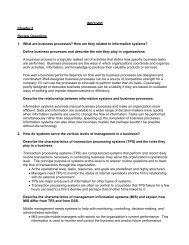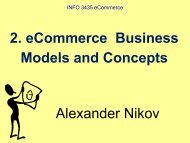QUESTIONS1. How does a social network differ from a portal? How are the two similar?2. What is an affinity community and what is its business model?3. What is personalization, or personal value pricing, and how can it be used atthe beginning of a product’s life cycle to increase revenues?4. List and briefly explain three of the benefits of auction markets.5. What are the two price allocation rules in auction markets? Explain thedifference.6. What types of products are well-suited for an auction market? At what points inthe product life cycle can auction markets prove beneficial for marketers?7. What are the two main types of vertical market portals and how are theydistinguished from one another?1. How does a social network differ from a portal? How are the twosimilar?• <strong>Social</strong> networks involve a group of people, shared social interaction, common tiesamong members, and people who share an area for some period of time. Portals aregeneral-purpose content providers that have a varied selection of features andcapabilities. <strong>Social</strong> networks are different from portals in that content creation is donealmost exclusively by the members of social networks, whereas portals both createand aggregate content from elsewhere. The two are similar in that their goal is tokeep visitors on their sites for a long time, or to mold themselves as a “sticky”destination site. Also, many portals have social networking features.8-458-462. What is an affinity community and what is its business model?• An affinity community is one in which members can participate in focuseddiscussions with others who share the same affinity, or group identification, such asreligion, ethnicity, gender, sexual orientation, or political beliefs. The business modelis a mixture of subscription revenue from premium content and services, advertising,tenancy/sponsorships, and distribution agreements.3. What is personalization, or personal value pricing, and how can it beused at the beginning of a product’s life cycle to increase revenues?• Personalization or personal value pricing is when merchants adjust prices based ontheir estimate of how much a customer truly values the product. For example, Webmerchants may charge committed fans of a musician a higher price for the privilegeof receiving a new CD before its official release to retail stores. It is a specific type ofdynamic pricing in which merchants match their prices to the personal value thatconsumers will receive from a purchase by estimating what they believe any givenconsumer is willing to pay. It can be used at the beginning of a product’s life cycle toincrease revenues because a certain consumer segment, the so-called earlyadopters,is willing to pay more for a newly released product.8-478-48
4. List and briefly explain three of the benefits of auction markets.• Liquidity: Sellers and buyers are connected in a global marketplace.• Price discovery: Even difficult to price items can be competitively priced based onsupply and demand.• Price transparency: Everyone in the world can see the asking and bidding prices foritems, although prices can vary from auction site to auction site.• Market efficiency: Consumers are offered access to a selection of goods that wouldbe impossible to access physically, and consumer welfare is often increased due toreduced prices.• Lower transaction costs: Merchants and consumers alike are benefited by thereduced costs of selling and purchasing goods compared to the physicalmarketplace.• Consumer aggregation: A large number of consumers who are motivated to buy areamassed in one marketplace—a great convenience to the seller.• Network effects: The larger an auction site becomes, in both the numbers of usersand products, the greater all of the above benefits become and therefore the morevaluable a marketplace it becomes.• Market maker benefits: Auction sites have no inventory carrying costs or shippingcosts, making them perhaps the ideal online business in that their main function isthe transfer of information.8-495. What are the two price allocation rules in auction markets? Explain thedifference.• The two price allocation rules in auction markets are uniform pricing anddiscriminatory pricing. When a uniform pricing rule is in effect, there are multiplewinners who all pay the same price, usually the lowest winning bid. The lowestaccepted offer sets the price. When a discriminatory pricing rule is in effect, winnerspay different amounts depending on the amount they bid. Each customer pays itswinning bid.8-506. What types of products are well-suited for an auction market? At what pointsin the product life cycle can auction markets prove beneficial for marketers?• The types of products that are well-suited for an auction market include rare andunique products where prices are difficult to discover and where there may havebeen no market for the goods. These include perishable items such as airline tickets,hotel rooms, car rentals, or tickets to plays, concerts, and sporting events.Traditionally, auctions have been used by businesses to generate a higher profit onitems at the end of their life cycle than they would receive from product liquidationsales. However, they are now more frequently being used at the beginning of aproduct’s life cycle to generate premium prices from highly motivated early adopters,for example: early releases of music, books, DVDs, video games, and digitalappliances.7. What are the two main types of vertical market portals and how arethey distinguished from one another?• The two main types of vertical market portals are affinity group portals and focusedcontent portals. Affinity group portals seek to attract statistical aggregates of peoplewho identify themselves by their attitudes, values, beliefs, and behavior. They exist toserve such broad constituencies as women, African Americans, and gays as well asmuch more focused constituencies like union members, religious groups, and evenhome schooling families. Focused content portals contain in-depth information on aparticular topic that all members are interested in. They can provide content on suchbroad topics as sports, news, weather, entertainment, finance, and business, or theycan appeal to a much more focused interest group such as boat, horse, or videogame enthusiasts.8-518-52
















